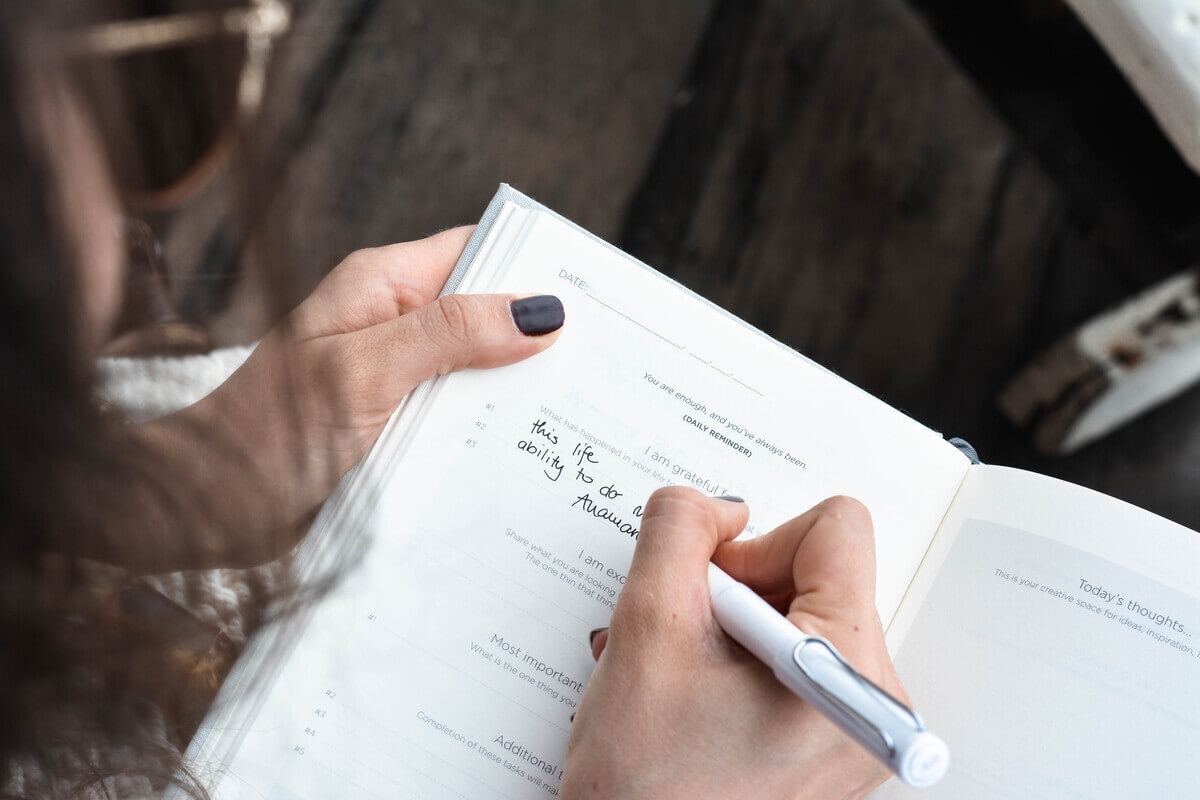Gratitude is one powerful concept going up in the hottest trends of personal development. It’s about the quality of being thankful and the readiness to show appreciation for people or events in your life.
But putting it into practice might be easier said than done for some people. That’s why keeping a gratitude journal could be a solution to showing your love and kindness for the amazing things that you already experience.
Setting a new routine in place could feel overwhelming and come with some critical thoughts. However, as journaling expert and founder of Prophsee®, Ana Juma, says, “It doesn’t have to be perfect; it only has to start.” Here is a great place to take the first step.
What Is a Gratitude Journal?
A gratitude journal means the practice of writing down things you feel grateful about regularly.
People who practice gratitude are predominantly happy and easygoing because they always see the positive in most negative situations.
But it’s often when we need gratitude the most that it’s difficult to find. When you’re overcome with grief, sadness, anxiety, or anger, it’s hard to see what’s going right in your life. And that is why the practice itself is a healing and transformational habit to integrate into your routine.
The (Many) Benefits of a Gratitude Journal
Because our minds have been wired to focus on the negative, keeping a gratitude journal helps you counteract this negativity bias. “You develop the mental muscle to focus on the good things in your life,” explains Ana. “They’re already there but often left unnoticed.”
Studies have also shown that expressing gratitude on a daily basis is linked to overall higher levels of happiness and contentment. Moreover, it is strongly associated with well-being and, as the studies reported, this link may be unique and causal.
A few more benefits of this kind of journaling practice include:
- Mood improvement
- Better sleep
- Stronger immune system
- More hope for the future
- Greater awareness of the present moment
- Finding the beauty in little moments
By disabling painful or seemingly debilitating problems, the simple act of practicing gratitude can bring joy, hope, and light to the darkest of times.
If you do nothing else but live these values every single day, you cannot imagine how fulfilling your life will become.
— Paul McKenna, trainer of Mindvalley’s Everyday Bliss Quest
Examples of Gratitude Journal Prompts
When you don’t know what to be grateful for, some guidance and inspiration may serve you. You can read a few gratitude quotes to spark your interest in how transformational this practice can be for you.
Then, Ana recommends some journaling prompts that really drive you to reflect on the beautiful things in your life:
- What made me smile today?
- Who are the people that make my life extraordinary?
- What do I love about (something or someone)?
- What do I admire about myself?
- How is this challenge helping me grow?
- What do I appreciate about my work?
- Why does my body love me unconditionally?
- Why am I so lucky?
Happiness isn’t found in things. Rather, it’s gratitude for what we have that creates happiness. Following the concept of the Law of Attraction, where like attracts like, more happiness will gravitate toward those individuals who are already happy.
Gratitude doesn’t come naturally to everyone. Aiming for goals that aren’t met can make it difficult to pause and genuinely feel grateful for what you have.
But here’s the great news about gratitude: it gets easier with practice, and the perfect way to practice is to start a gratitude journal ritual.

How to Create a Gratitude Journal Ritual
Learning how to start a gratitude journal is pretty easy—buy a blank notebook (preferably one that inspires you) and write down a few things for which you’re grateful as often as you feel (daily, once, or twice a week).
If this minimalist solution works for you, go for it. But, if you need a different approach, here’s a step-by-step guide to creating your journaling ritual.
1. Select your journal with care
Make the ritual of gratitude journaling as fun as possible.
Pick out a journal that visually stimulates you or decorates an ordinary, inexpensive notebook with cherished pictures of people or things you love and care about (your children or pets, or inspirational words and images).
Get creative and have fun personalizing your gratitude journal. You are more likely to maintain the regular habit of journaling if you love the look of your journal.
Make your journal selection a special, rewarding experience. Go to a store that carries a variety of journals, or search online, and treat yourself to a journal that inspires you. Gift yourself with a gratitude journal that you’ll love to look at every night.
2. Create a ritual with intention
Even before you begin writing in your gratitude journal, choose a ritual to repeat every time you journal. Consistency is the key here. Rituals implement a call to action for your mind, body, and spirit through your muscle memory. Importantly, rituals create habits.
A few suggestions are:
- Lighting a candle
- Playing a favorite song
- Drinking a cup of tea
- Taking a relaxing bath
- Saying a calming prayer
- Chanting a meditation
Anything you decide to do is a great way to let your mind and body know that it’s time to focus on gratitude. Whatever you choose as a ritual, do it consistently. It strengthens the ability to turn action into a habit, and it’s usually fun and relaxing, giving us the motivation to form our habit.
You can also create a relaxing atmosphere by listening to a journaling music playlist, as recommended by Ana:
3. Express your gratitude
Gratitude journals can take on any desired format. Some journalers make a list of items to express it; others draw images or create a collage of pictures; while a few write a poem to capture and motivate their gratitude.
The way you express your life appreciation is very personal and totally up to you.
Even at the end of a terrible day, try to think of at least one good thing that happened that you can be grateful for, no matter how slight. Forget everything else, and just for a moment, write about that one good life event and why you feel grateful for it.
4. Celebrate quality
Our minds respond better to quality than quantity. One truly grateful paragraph can outweigh a list of 50 items. The emotion of gratitude is difficult to connect with a long list.
Dive deep into your journal about even minor topics to help you reinforce gratitude in your life. Observe from within as your body and mind get used to experiencing it. The more you feel grateful for even the smallest parts of your life, the easier it will become for you.
5. Bookend your day
Regular, nightly writing in a gratitude journal is important because it closes your day on a high note. It empowers the feelings in your mind and helps you infuse the thoughts into your spirit.
This cue to your subconscious uses dreams to process and understand the important feelings you associate with those thoughts.
Celebrate a positive attitude for the start of your day by re-reading your gratitude journal entry in the morning. It is simply a double-ended bonus.
How to Maintain the Habit of a Gratitude Journal
The trouble with happiness is that people don’t practice it.
— Paul McKenna, trainer of Mindvalley’s Everyday Bliss Quest
Positive reinforcement, along with repeating your journal habits, can keep you motivated. Journaling habits are a matter of personal choice, so Ana advises you to get creative:
“Experiment with other formats if writing a gratitude list becomes monotonous over time. For example, try writing a short description of something you’re thankful for, write a letter to a beloved one, or make a weekly gratitude visual board of what brings you joy. The possibilities are endless.”
Here are a few more tips on how to keep this gratitude journal practice:
1. Keep a daily gratitude journal
For many, daily repetition is the only way to reinforce a habit. If you are the type of person who gets a thrill out of achieving goals, this is a good method for you.
Set your alarm every day to remind yourself of the commitment to write in your gratitude journal.
2. Write at least once a week
For others, keeping a daily record is so overwhelming that the goal is soon given up altogether.
Daily journal writing may be too much for you. That’s totally okay—gratitude journals are effective, not because you do them every day, but simply because you get your mind and body accustomed to expressing gratitude.
Also, it’s natural for everyone to feel low on certain days when nothing seems to fall into place. And forcing yourself to be grateful all the time might push you into a toxic gratitude perspective that can do more harm than good.
Target a goal of journal writing once a week. Set an alarm for Saturday or Sunday, and if you still haven’t written in your journal that week, go ahead and do it that night. Most people fall into this category, so don’t beat yourself up about only writing once a week.
3. Reward yourself every time you write
For some, an immediate reward is the key to sustaining a daily journal (or anything). Simple self-sleuthing may uncover the fact that your only long-term habits are those that provide instant gratification. Don’t blame your brain chemistry.
The good news is that starting a habit is easy. Select your motivating reward and give it to yourself on a short or long-term schedule that makes sense to you, whether nightly or after 30 uninterrupted days of journal writing.
Gratitude Sets You Free
Gratitude comes with acceptance. And once we truly make peace with how things are, then we become free to invite change into our lives.
Being grateful shifts your perspective on current situations and difficulties that you may be going through. It helps you flow through life with more grace and ease.
Your experience of life is primarily affected by the perspective you view it from. Depending on the meaning we give to situations or events, we will feel and behave differently.
— Paul McKenna, trainer of Mindvalley’s Everyday Bliss Quest
It’s true that sometimes gratitude doesn’t feel so natural. However, the more you practice it, the easier it will be to focus on the good things that show up in your reality.
And if you need some guidance along the way, Mindvalley can be the answer for you. With wise insights from transformational Quests such as Everyday Bliss with Paul McKenna, you can learn how to live your life with more gratitude, joy, and overall fulfillment.
By unlocking your free access today, you can sample classes from this program and many others. What is more, there are selected daily meditations you can do that may help to release any mental blockages you feel against gratitude and abundance.
There are so many things in this life to be grateful for. You can choose to notice them today.











